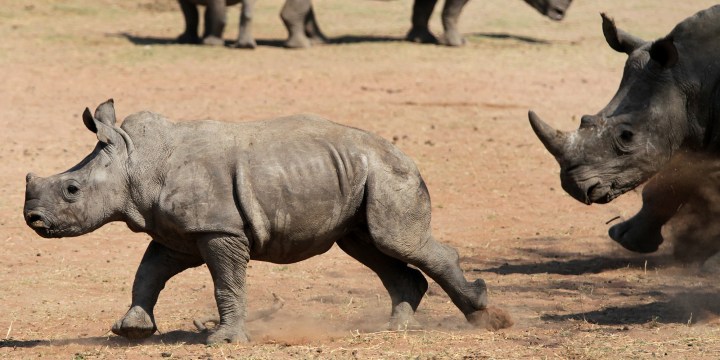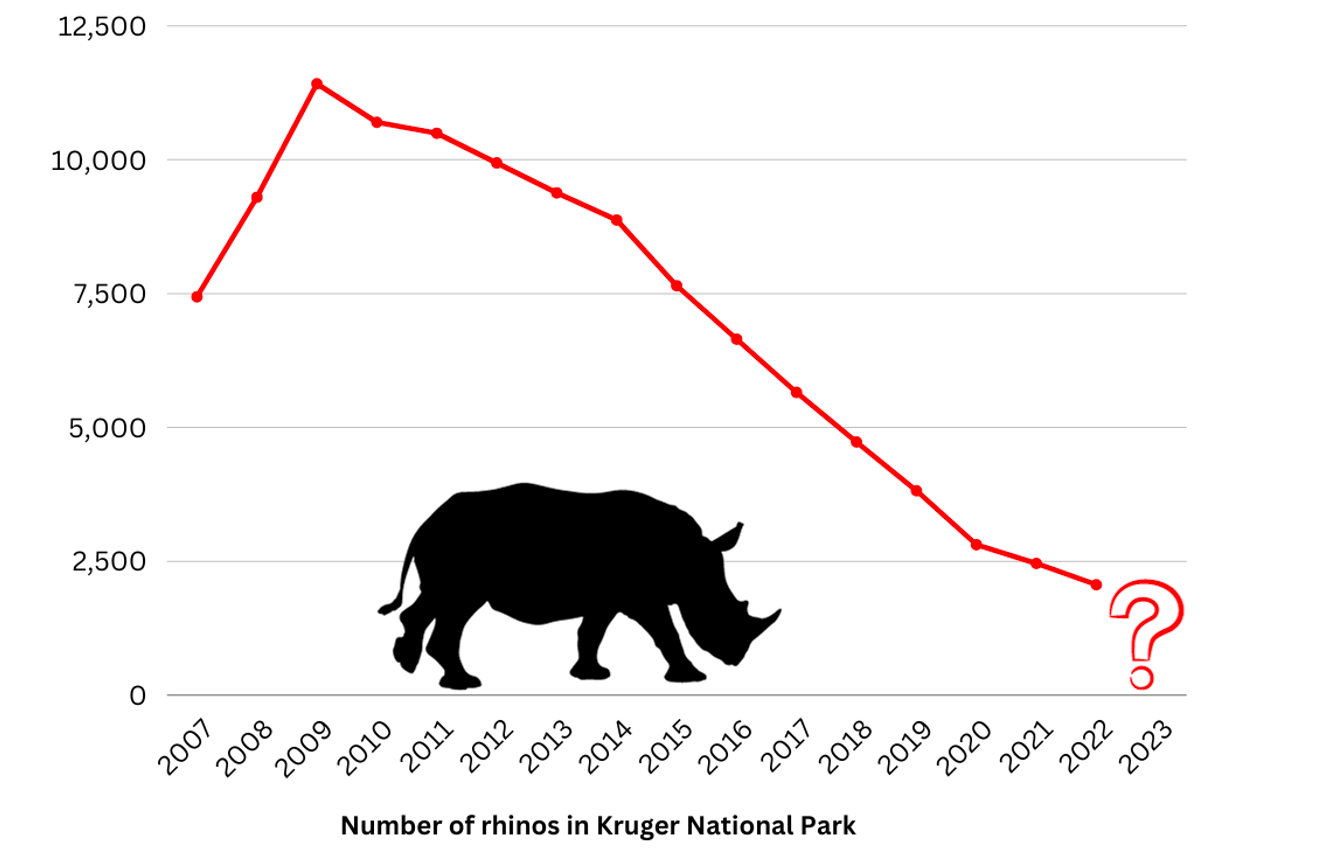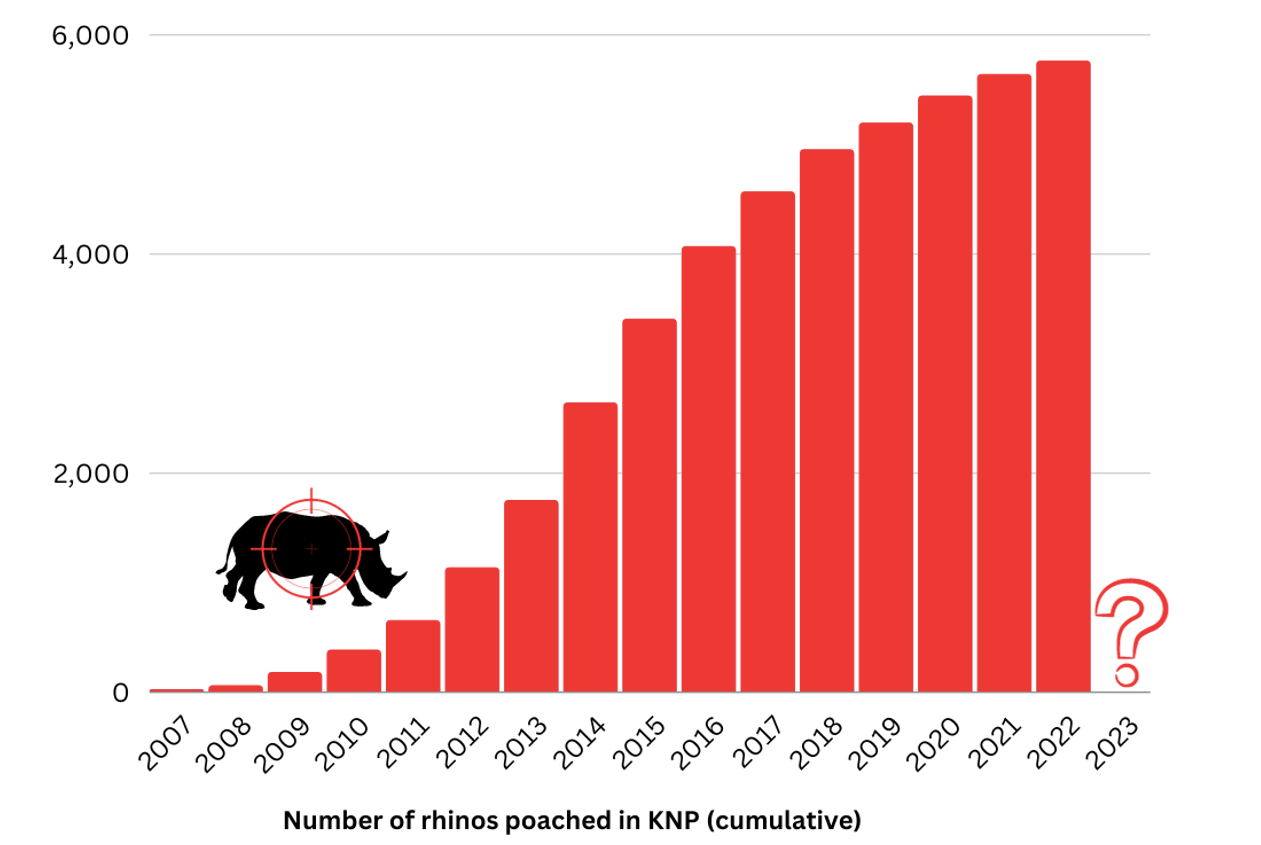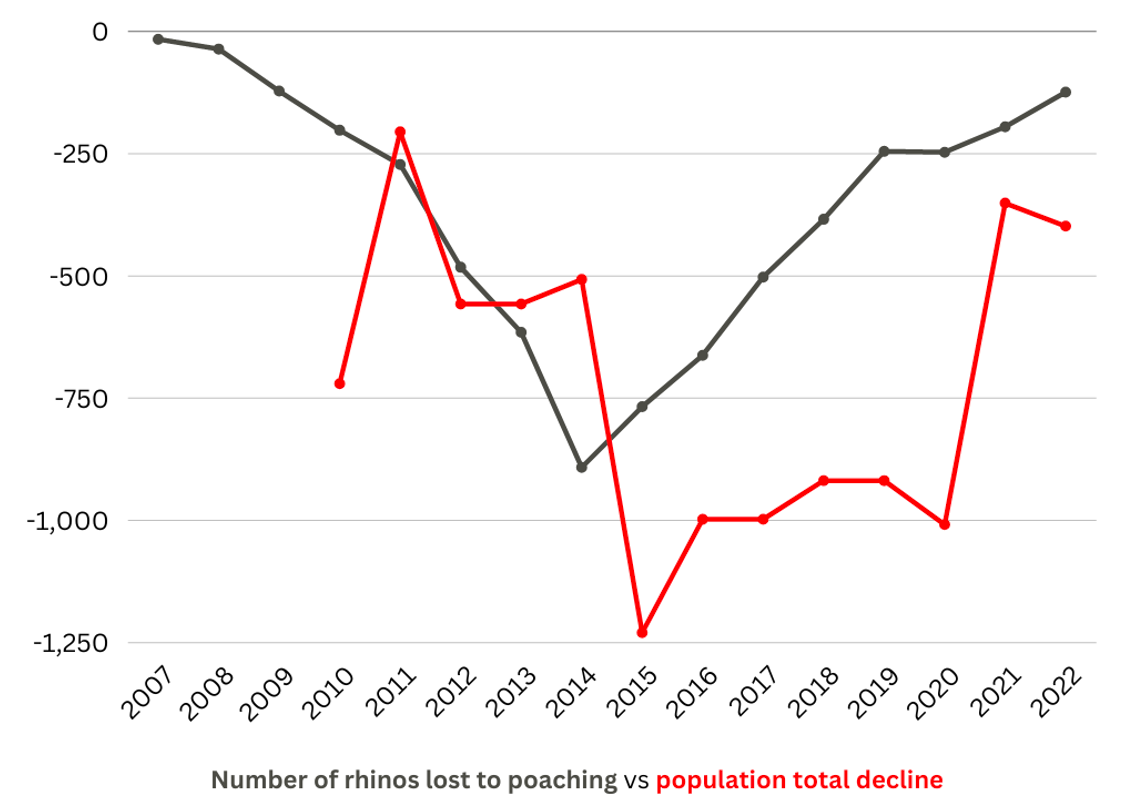WILDLIFE SLAUGHTER OP-ED
Kruger’s rhinos continue to face unrelenting threats and catastrophic population declines

Rhinos are not the only wildlife threatened by poaching: elephant poaching in the Kruger National Park has seen a dramatic increase in the past year, with 32 elephants killed, compared to nine in 2021/2022 – a 225.56% rise.
There are an estimated 2,060 rhinos left in the Kruger National Park after a decline in numbers of 16.2% during 2022 – despite a substantial drop in poaching.
This was revealed in SANParks’ recently released 2022/2023 Annual Report. At first glance, it appears from the reported 49.74% decrease in rhino poaching that the fight against poaching is being won. But, taken in context, Kruger’s rhinos continue to face unrelenting threats and catastrophic population declines.
After a long period of silence and an unanswered parliamentary question regarding Kruger’s rhino population, the latest annual report indicates that, at the end of 2022, there were 2,060 rhinos (a median of 1,851 white rhinos and 210 black rhinos) remaining in the Kruger compared to 2,458 black and white rhino at the end of 2021. This is a decline of 398 animals, or 16.2% of the population.
There is a worrying lack of a sense of urgency in the report despite these extremely concerning numbers.


‘Lost’ rhino numbers
During 2022, 124 rhinos were lost to poaching – an average of one rhino every three days – compared with 195 in the preceding year. Yet, according to SANParks, “there has been a decline in rhinos of 19.58% in core conservation areas within the national park, most likely due to rhinos moving out in response to continued poaching pressure”.
SANPark’s annual report appears somewhat optimistic that a 4% population growth target has been met in smaller national parks outside the Kruger. Additionally, the report frequently highlights that poaching rates have decreased by 49.74% in Kruger, but comparing poaching numbers to the decline in rhino populations in Kruger National Park paints a distressing picture.

From 2011, a marked decline in the rhino population can be seen, but what stands out here is an unexplained discrepancy between poached rhinos and the overall population decline. From 2015 onwards, in particular, the decline far exceeds the poached rhinos, but surely this can’t be attributed to natural deaths alone? Kruger officials have not offered explanations for this discrepancy, but rather focus on the decline in poaching numbers only.
It is clear in the graph above that an evident decrease in poaching numbers to 2015 is far from sufficient cause to applaud meeting targets. Smaller losses to poaching are also heavily influenced by the fact that so few animals remain — and that gap is closing.
To put this in perspective, there were an estimated 7,000 white rhinos and 440 black rhinos in 2007.
Despite a reported 70% of Kruger’s rhino population being dehorned during the 2022/2023 reporting period, the continued decline remains staggering.
With the majority of the anti-poaching deployments in the southern regions of the park, the 2022/2023 report notes that five white rhino orphans were recovered in addition to 17 injured white rhinos and two black rhinos being treated after surviving poaching attempts.
The poaching rate (a percentage of the average estimated rhino population) in Kruger alone remains fairly steady at 7.1% for white rhino and 3.4% for black rhino as of the end of 2022. This has only slightly been reduced from a combined high of 9.8% for both white and black rhino in 2014.
Range expansion or a lost fight?
In May 2023, Environment Minister Barbara Creecy responded to a parliamentary question regarding the designation of rhino sanctuaries, stating that no rhinos to date had been moved out of the Kruger National Park. The annual report, however, states that disease-free rhinos have been moved to unspecified locations in collaboration with the Wilderness Foundation.
Are these translocations occurring as a final resort to protect the few animals that do remain and an admission that rhinos cannot be adequately protected in Kruger? Or is this softened as “range expansion” as written in the report?
With confirmation now in the annual report that rhino translocations have started, two concerns are not clarified: what factors affect the “limited potential” of such translocations and, given the constant extreme threat facing rhinos, how will they be secured elsewhere, especially in light of the contradiction that smaller and more vulnerable populations are being targeted? Has the Kruger National Park lost the fight against poaching syndicates?
Corruption and vacant posts
Crime analyst Julian Rademeyer’s recent report, Landscape of Fear, draws urgent attention to Kruger’s greatest threat – internal corruption and a network of criminal activities in Mpumalanga. According to the report, the onslaught of poaching is deeply entwined in internal corruption, a burgeoning crisis given the proliferation of organised crime and entrenched poaching syndicates in communities and areas surrounding the park.
The increased violence has been met with an increasingly militarised response from anti-poaching units. And like all proclaimed “wars”, the toll on human life in the name of fighting the “war on poaching” continues to climb to new heights too.
In an effort to curb internal corruption, SANParks attempted to introduce integrity testing. The new approach, involving lie detector tests to tackle corruption, was met with controversy and resistance, and the method was not without its disadvantages which would have called its validity into question.
To address these concerns, the annual report outlines a Ranger Services Integrity Management Plan (RS-IMP) for the Kruger, which was approved on 23 November 2022. This new policy appears to take a more holistic approach, including lifestyle audits and background checks, with a focus on fostering core values and resilience within Kruger’s staff. The annual report makes no mention of the number of staff who have committed to engaging in the integrity management plan. New recruits who would be engaging with this new policy are severely limited as finances are so constrained that at least 52 new posts within the Kruger remain unfilled.
Relationships and working conditions within the park are currently so tense, according to Head Ranger Kathy Dreyer – quoted in Rademeyer’s report – that “we are certainly not going to recruit 52 people and put them into what is not a nice work environment at the moment. It’s not right for them and it is not right for us. If you bring anyone in now, you’re just going to break him or her.”
For now, Dreyer says, the new integrity management policy needs to be implemented before these vacancies can be addressed.
Rademeyer’s report prompted SANParks Board Chairperson Pam Yako to commit to responding, but this has not yet happened and is not as yet on the Parliamentary Portfolio Committee’s calendar.
SANParks’ annual report, likewise, does not refer to information in the Landscape of Fear report and only has passing mention of the fight against internal corruption, alongside the corporate communication department’s acknowledgement that internal corruption among Kruger staff remains a source of negative media attention.
While this move towards a holistic integrity management policy is a step in the right direction, do Kruger’s rhinos have time to wait on the development of standard operating procedures and implementation amid escalating violence and corruption? Can the anti-poaching units currently working tirelessly on the ground wait for improved working conditions as they face increased violence to protect Kruger’s rhinos?
The situation is nothing short of a crisis – but where is the sense of an emergency?
Rhinos remain threatened
Targets and reported decreases in poaching numbers aside, rhinos continue to face critical threats in the Kruger National Park. Unfortunately, it would appear the government is only now starting to admit how dire the situation really is – in Creecy’s statement that “it has become evident that … a species recovery plan for white rhino” is needed.
Rhinos are not the only wildlife threatened by poaching: elephant poaching has seen a dramatic increase in the last reporting year alone, with 32 elephants poached compared with nine in 2021/2022 – a 225.56% increase.
World Rhino Day on 22 September was met with mixed feelings of trepidation and small, cautious glimmers of hope: despite poaching pressure, the International Rhino Foundation’s State of the Rhino 2023 report indicates that the black rhino population is slowly increasing. The white rhino population, however, continues to experience declines.
One of South Africa’s hardest-hit regions is KwaZulu-Natal. With increased security measures across the Kruger National Park, it would appear poaching syndicates are targeting smaller and more vulnerable populations. This calls into question the policy of moving rhino out of Kruger.
SANParks’ annual report feels underwhelming. There is simply no debate about Kruger’s rhinos. The truth is that each remaining rhino is now critical to saving the species from extinction.
The SANParks communications team has not yet responded to our questions and requests for clarification. DM
Dr Stephanie Klarmann is a conservation psychology researcher based in South Africa. Her work has focused primarily on envisioning a conservation psychology relevant to the South African context with a stronger focus on issues of justice, coexistence and capacity building.



















 Become an Insider
Become an Insider
Poaching kills rhinos. Farming them allows the harvesting of the horn without harming the animal. I hope Barbara Creecy is aware that her policy of not allowing horn sales is causing the slow extinction of the rhino.
It’s not just a matter for Barbara Creecy. Trade in rhino horn is banned worldwide by CITES. Even if trade in rhino horn was legalised, it would take so many years to build up enough stock to supply the demand, that the poaching would just continue. The product is so expensive ($20 000 per kg) that there will always be an incentive to kill wild rhinos. Also, it is believed that consumers in China and Vietnam prefer and are willing to pay more for wild rhino horn. The crazy psychology of this market is that buying rhino horn is a kind of flaunting of great wealth. I think that the only hope for rhinos would be a massive crackdown in China and Vietnam, but I don’t think that will ever happen. Sadly, rhinos are doomed.
Who believes they would pay more for wild horn? Farmed horn is not available! They have not had make the choice! There are more privately owned rhinos than State owned ones, farmed horn would soon supply demand, and reduce the price. Poaching would continue, but at a much reduced rate. Rhinos are only doomed if Creecy continues with her policies. If she changes them CITES would have to comply.
Apparently DM does not allow posting of links or URLs, but there is a study online done by Universities of Copenhagen and Hanoi last year. They interviewed over 300 Rhino horn consumers in Vietnam. The findings are interesting. They conclude that a legal trade in horn would mitigate but not eliminate a continuing black market. They found that the wealthiest consumers would be willing to pay more for wild or semi-wild horn.
This is only able to occur because the authorities are complicit!!!